change wheel CHEVROLET CAVALIER 1995 3.G Owners Manual
[x] Cancel search | Manufacturer: CHEVROLET, Model Year: 1995, Model line: CAVALIER, Model: CHEVROLET CAVALIER 1995 3.GPages: 340, PDF Size: 17.09 MB
Page 84 of 340
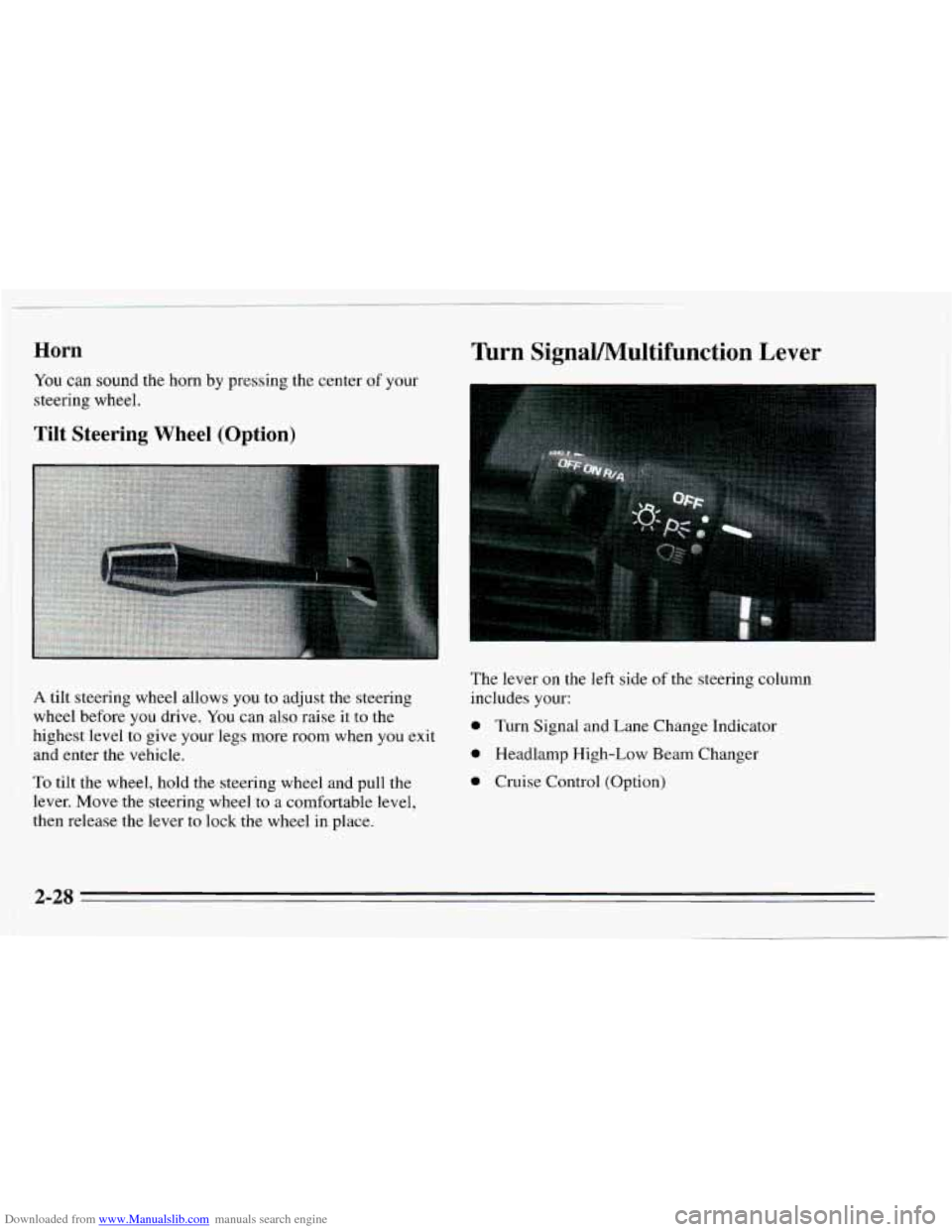
Downloaded from www.Manualslib.com manuals search engine Horn
You can SOM~ the horn by pressing the center of your
steering wheel.
Tilt Steering Wheel (Option)
Turn SignaVMultifunction Lever
A tilt steering wheel allows you to adjust the steering
wheel before you drive. You can
also raise it to the
highest level to give your legs more room when
you exit
and enter the vehicle.
To tilt the wheel, hold the steering wheel and pull the
lever. Move the steering wheel to
a comfortable level,
then release the lever to lock the wheel in place. The
lever
on the left side of the steering column
includes your:
0 Turn Signal and Lane Change Indicator
0 Headlamp High-Low Beam Changer
0 Cruise Control (Option)
2-28
Page 147 of 340
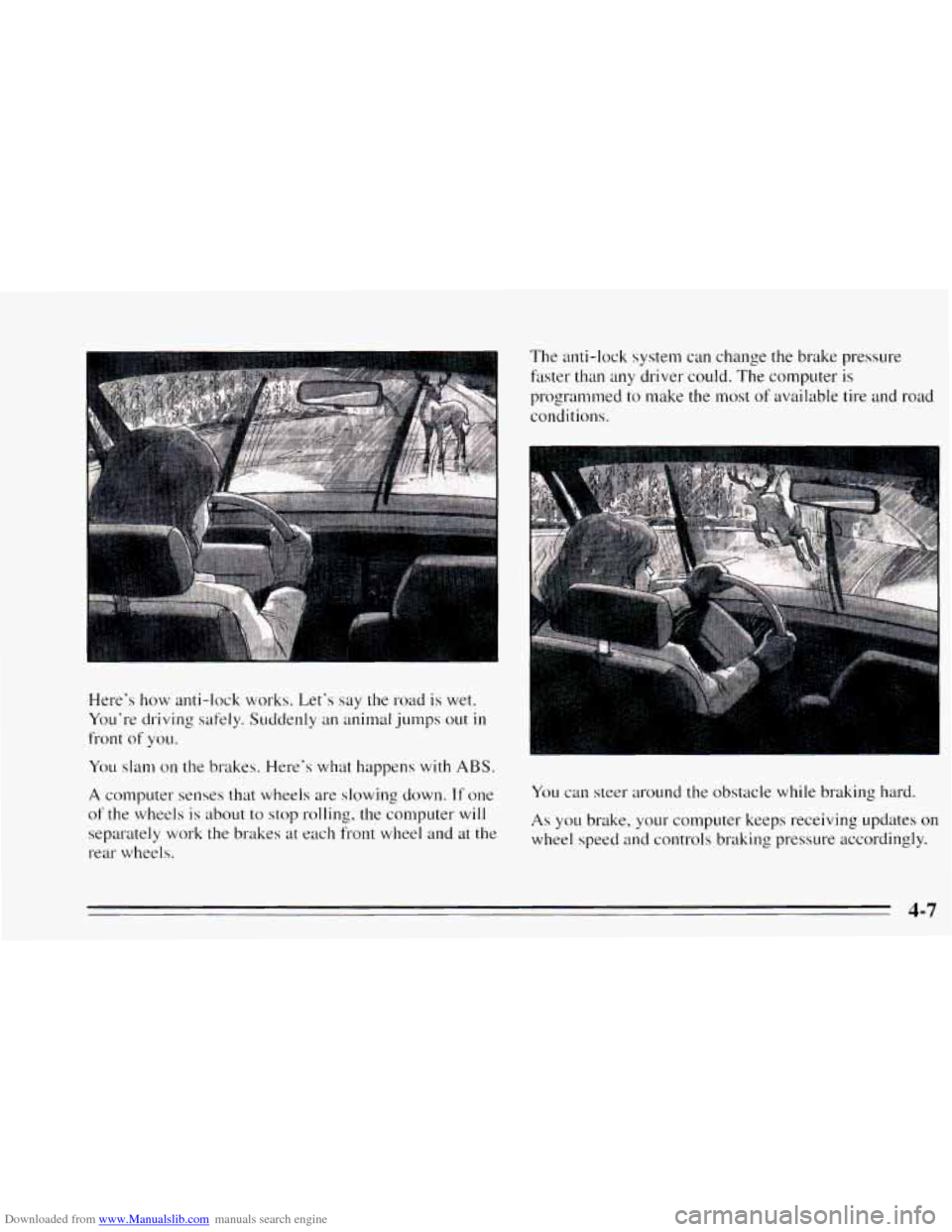
Downloaded from www.Manualslib.com manuals search engine Here's how anti-lock works. Let's say the road is wet.
Yo~1'1-e driving safely. Suddenly an animal jumps out
in
front of YOLI.
You slam on the brakes. Here's what happens with ABS.
A computer senses that wheels are slowing down. If one
of the wheels is about to stop rolling, the computer will
separately work
the brakes at each front wheel and at the
rear wheels. The anti-lock
system can change the brake pressure
faster than any driver could. The computer is
programmed to make the most
of available tire and road
conditions.
You can steer around the obstacle while braking hard.
As you brake, your computer keeps receiving updates on
wheel speed and controls braking pressure accordingly.
Page 148 of 340
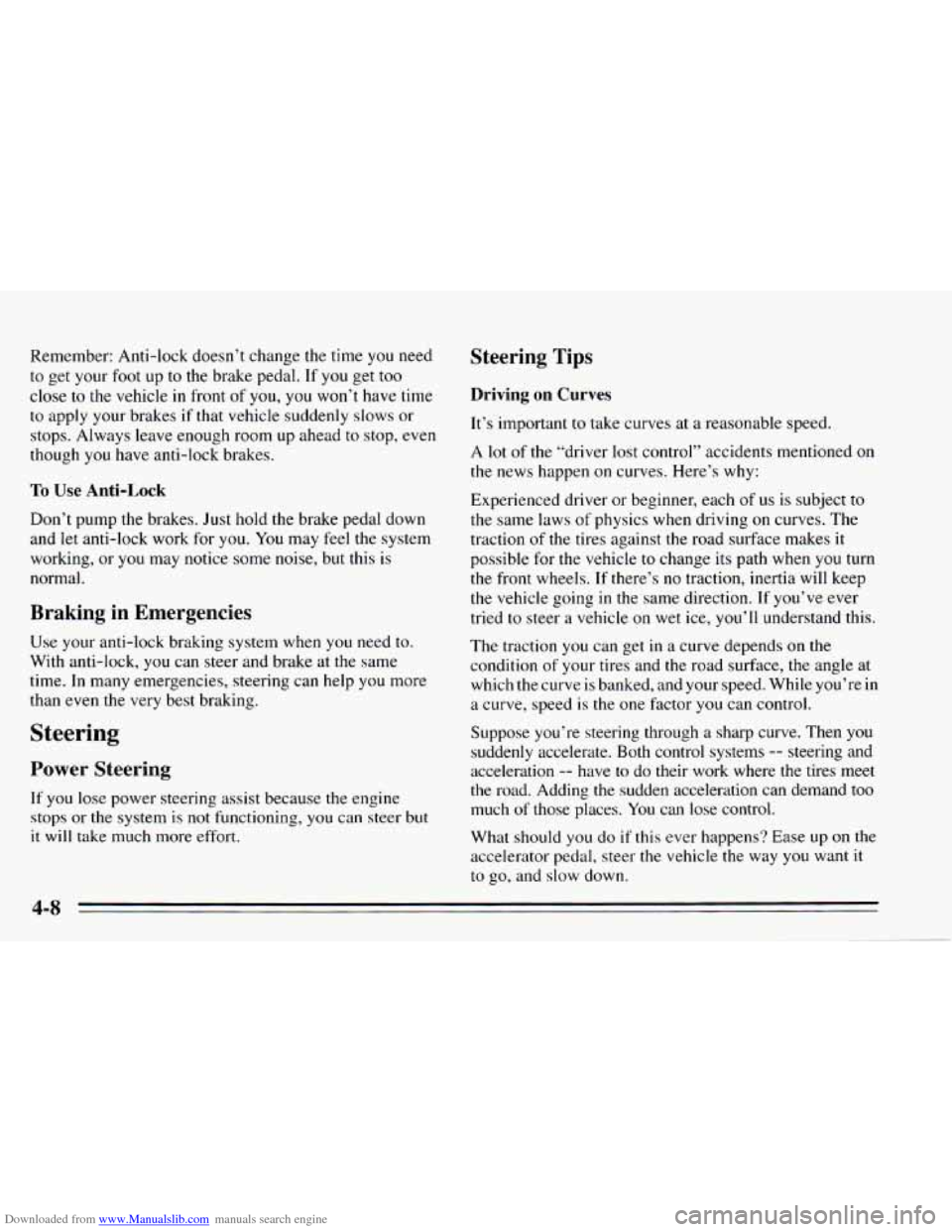
Downloaded from www.Manualslib.com manuals search engine Remember: Anti-lock doesn’t change the time you need
to get your foot up
to the brake pedal. If you get too
close to the vehicle in front of you, you won’t have time
to apply your brakes if that vehicle suddenly slows or
stops. Always leave enough room up ahead to stop, even
though
you have anti-lock brakes.
To Use Anti-Lock
Don’t pump the brakes. Just hold the brake pedal down
and let anti-lock work for you. You may feel the system
working, or you may notice some noise, but this
is
normal.
Braking in Emergencies
Use your anti-lock braking system when you need to.
With anti-lock,
you can steer and brake at the same
time. In many emergencies, steering can help you more
than even the very best braking.
Steering
Power Steering
If you lose power steering assist because the engine
stops or the system is
not functioning, you can steer but
it will take much more effort.
Steering Tips
Driving on Curves
It’s important to take curves at a reasonable speed.
A lot of the “driver lost control” accidents mentioned on
the news happen on curves. Here’s why:
Experienced driver or beginner, each
of us is subject to
the same laws of physics when driving
on curves. The
traction
of the tires against the road surface makes it
possible for the vehicle to change its path when you turn
the front wheels. If there’s no traction, inertia will keep
the vehicle going in the same direction. If you’ve ever
tried
to steer a vehicle on wet ice, you’ll understand this.
The traction
you can get in a curve depends on the
condition of your tires and the road surface, the angle at
which the curve is banked, and your speed. While you’re in
a curve, speed
is the one factor you can control.
Suppose you’re steering through
a sharp curve. Then you
suddenly accelerate. Both control systems -- steering and
acceleration
-- have to do their work where the tires meet
the road. Adding the sudden acceleration can demand too
much
of those places. You can lose control.
What should
you do if this ever happens? Ease up on the
accelerator pedal, steer the vehicle the way you want it
to go, and slow down.
4-8
Page 152 of 340
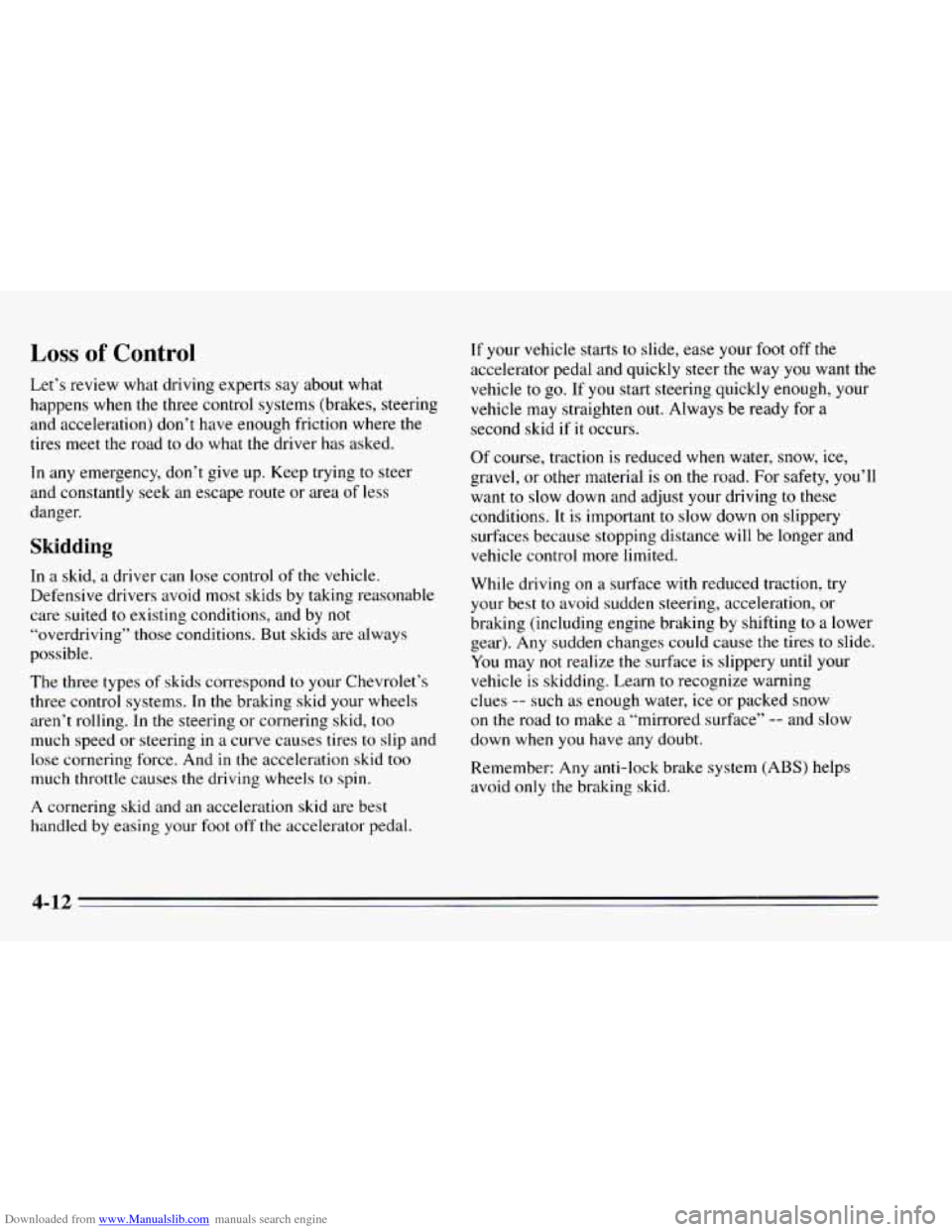
Downloaded from www.Manualslib.com manuals search engine Loss of Control
Let’s review what driving experts say about what
happens when
the three control systems (brakes, steering
and acceleration) don’t have enough friction where the
tires meet the road to do what the driver has asked.
In any emergency, don’t give up. Keep trying to steer
and constantly seek an escape route or area
of less
danger.
Skidding
In a skid, a driver can lose control of the vehicle.
Defensive drivers avoid most skids by taking reasonable
care suited
to existing conditions, and by not
“overdriving” those conditions. But skids are always
possible.
The three types
of skids correspond to your Chevrolet’s
three control systems. In the braking skid your wheels
aren’t rolling.
In the steering or cornering skid, too
much speed or steering in
a curve causes tires to slip and
lose cornering force. And
in the acceleration skid too
much throttle causes
the driving wheels to spin.
A cornering skid and an acceleration skid are best
handled by easing your
foot off the accelerator pedal.
If your vehicle starts to slide, ease your foot off the
accelerator pedal and quickly steer the way
you want the
vehicle
to go. If you start steering quickly enough, your
vehicle may straighten
out. Always be ready for a
second skid if
it occurs.
Of course, traction
is reduced when water, snow, ice,
gravel, or other material is
on the road. For safety, you’ll
want to slow down and adjust your driving to these
conditions. It is important
to slow down on slippery
surfaces because stopping distance will be longer and
vehicle control more limited.
While driving
on a surface with reduced traction, try
your best to avoid sudden steering, acceleration, or
braking (including engine braking by shifting to a lower
gear). Any sudden changes could cause the tires to slide.
You may
not realize the surfxe is slippery until your
vehicle is skidding. Learn to recognize warning
clues
-- such as enough water, ice or packed snow
on the road to make a “mirrored surface”
-- and slow
down when you have any doubt.
Remember: Any anti-lock brake system
(ABS) helps
avoid
only the braking skid.
4-12
Page 171 of 340
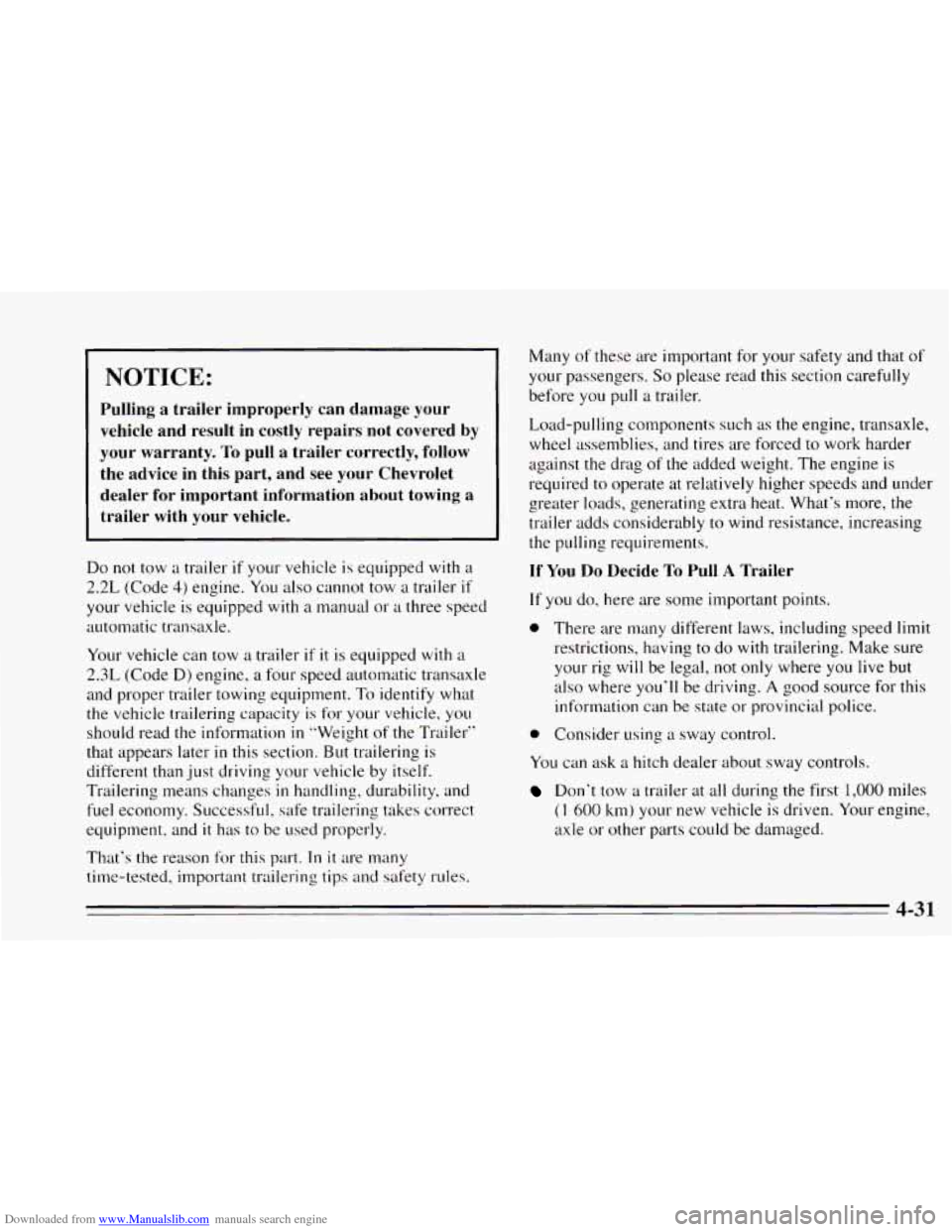
Downloaded from www.Manualslib.com manuals search engine NOTICE:
Pulling a trailer improperly can damage your
vehicle and result in costly repairs not covered
by
your warranty. To pull a trailer correctly, follow
the advice in this part, and see your Chevrolet
dealer for important information about towing a
trailer with your vehicle.
Do not tow a trailer if your vehicle is equipped with a
2.2L (Code 4) engine. You also cannot tow a trailer if
your vehicle is equipped with a manual or a three speed
automatic transaxle.
Your vehicle can tow a trailer
if it is equipped with a
2.3L (Code D) engine, a four speed automatic transaxle
and proper trailer towing equipment. To identify what
the vehicle trailering capacity
is for your vehicle, you
should read the information in “Weight of the Trailer”
that appears later in this section. But trailering is
different than
just driving your vehicle by itself.
Trailering means changes
in handling, durability, and
fuel economy. Successful, safe trailering takes correct
equipment, and
it has to be used properly.
That’s the reason for this
part. In it are many
time-tested, important trailering
tips and safety rules. Many
of these are important
for your safety and that of
your passengers. So please read this section carefully
before you pull a trailer.
Load-pulling components such as the engine, transaxle,
wheel assemblies, and tires are forced to work harder
against the drag
of the added weight. The engine is
required
to operate at relatively higher speeds and under
greater loads, generating extra heat. What’s more, the
trailer adds considerably
to wind resistance, increasing
the pulling requirements.
If You Do Decide To Pull A Trailer
If you do, here are some important points.
0 There are many different laws, including speed limit
restrictions, having to do with trailering. Make sure
your rig will be legal,
not only where you live but
also where you’ll be driving.
A good source for this
information can be state or provincial police.
0 Consider using a sway control.
You can ask a hitch dealer about sway controls.
Don’t tow a trailer at all during the first 1,000 miles
(I 600 km) your new vehicle is driven. Your engine,
axle or other parts could be damaged.
4-3 1
Page 175 of 340
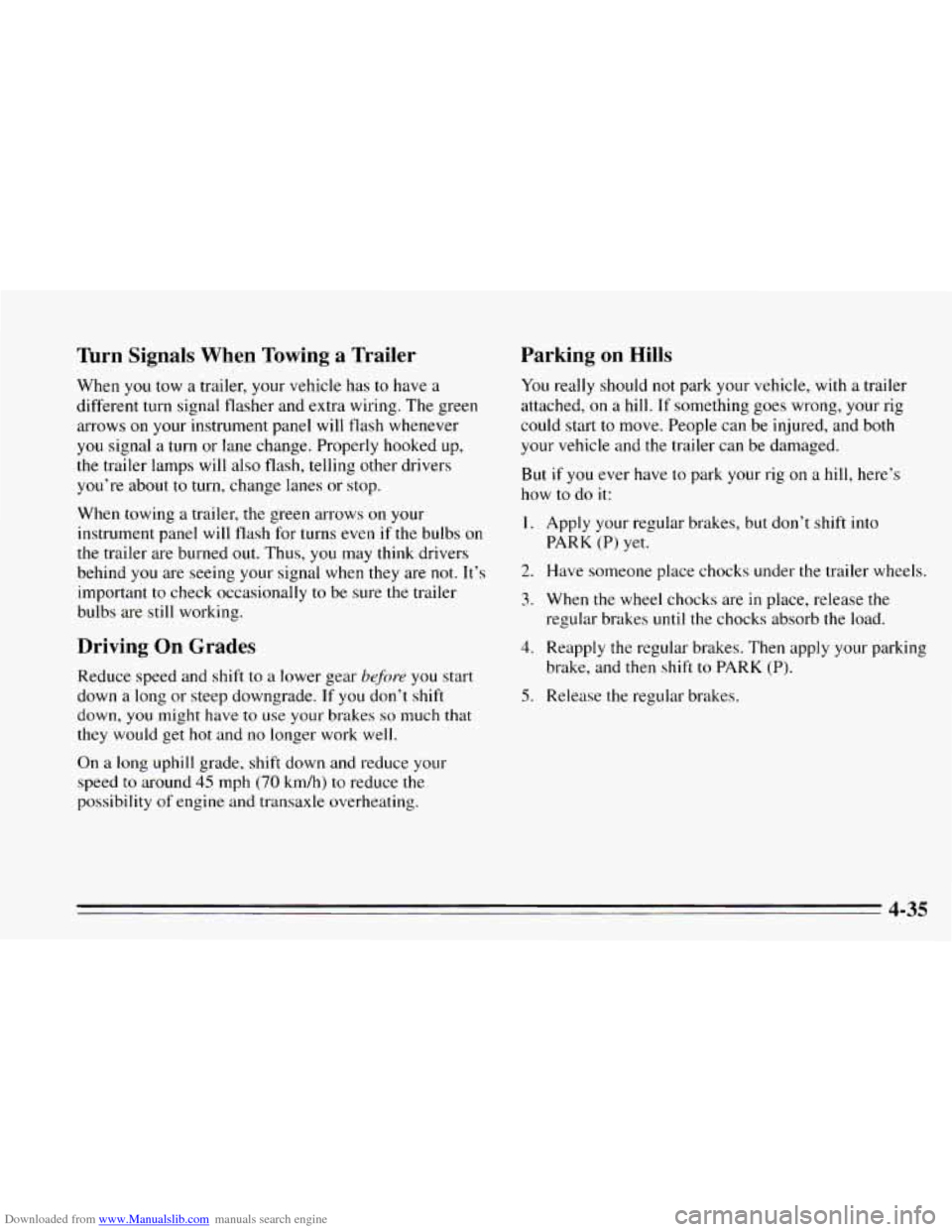
Downloaded from www.Manualslib.com manuals search engine Turn Signals When Towing a Trailer
When you tow a trailer, your vehicle has to have a
different turn signal flasher and extra wiring. The green
arrows on your instrument panel will flash whenever
you signal a turn or lane change. Properly hooked up,
the trailer lamps will also flash, telling other drivers
you‘re about
to turn, change lanes or stop.
When towing a trailer, the green arrows on
your
instrument panel will flash for turns even if the bulbs on
the trailer are burned out. Thus, you may think drivers
behind
you are seeing your signal when they are not. It’s
important
to check occasionally to be sure the trailer
bulbs are
still working.
Driving On Grades
Reduce speed and shift to a lower gear lwfot-e you start
down
a long or steep downgrade. If you don’t shift
down, you might have to use your brakes so much that
they would get hot and no longer work well.
On a long uphill grade, shift down and reduce your
speed
to around 45 mph (70 km/h) to reduce the
possibility of engine and transaxle overheating.
Parking on Hills
You really should not park your vehicle, with a trailer
attached,
on a hill. If something goes wrong, your rig
could start
to move. People can be injured, and both
your vehicle and
the trailer can be damaged.
But if you ever have to park your rig on a hill, here’s
how to do
it:
1. Apply your regular brakes, but don’t shift into
PARK (P) yet.
2. Have someone place chocks under the trailer wheels.
3. When the wheel chocks are in place, release the
regular brakes
until the chocks absorb the load.
4. Reapply the regular brakes. Then apply your parking
brake, and then shift
to PARK (P).
5. Release the regular brakes.
4-35
Page 183 of 340
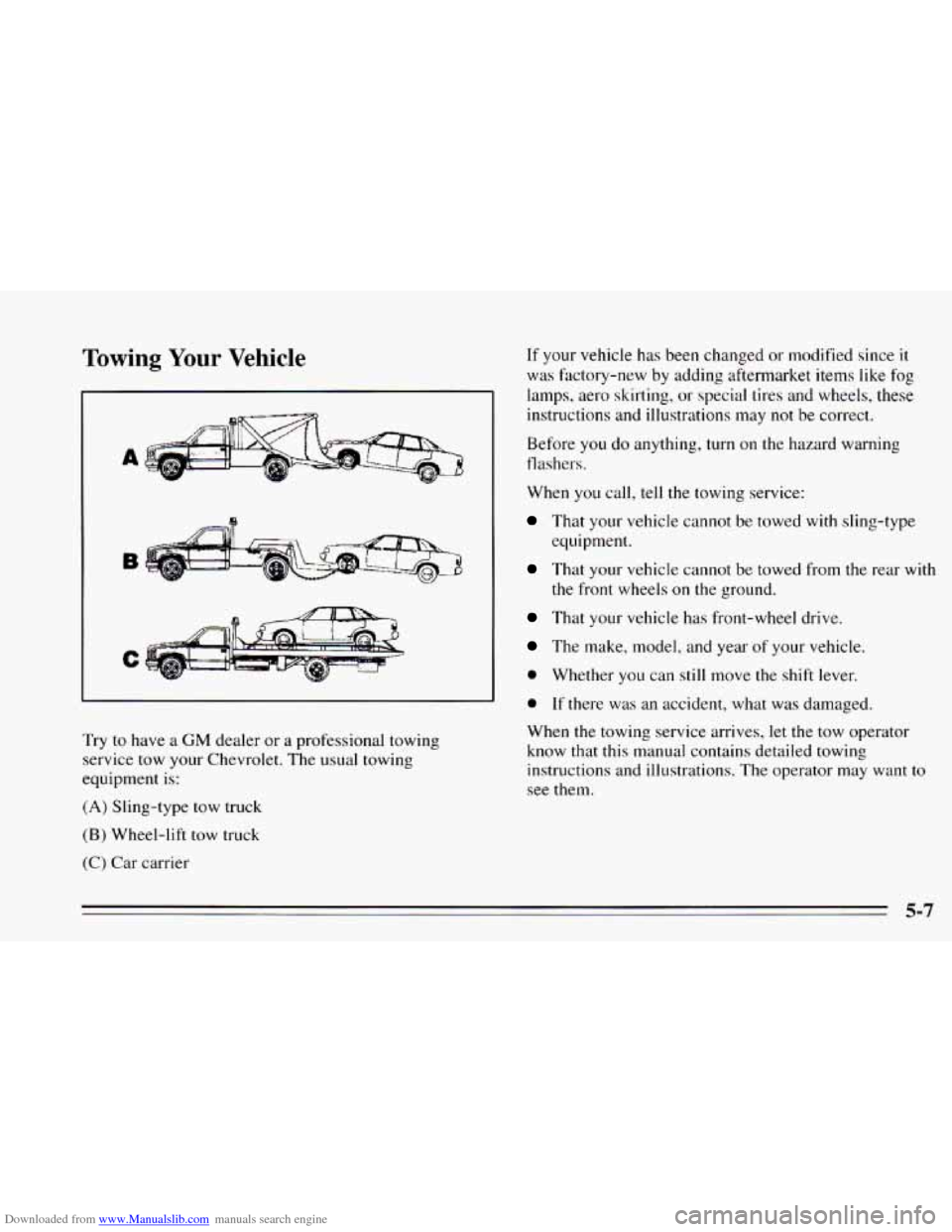
Downloaded from www.Manualslib.com manuals search engine Towing Your Vehicle
B
C
Try to have a GM dealer or a professional towing
service tow your Chevrolet. The usual towing
equipment
is:
(A) Sling-type tow truck
(B) Wheel-lift tow truck
(C) Car carrier
If your vehicle has been changed or modified since it
was factory-new by adding aftermarket items like fog
lamps, aero skirting, or special tires and wheels,
these
instructions and illustrations may not be correct.
Before
you do anything, turn on the hazard warning
flashers.
When you call, tell
the towing service:
That your vehicle cannot be towed with sling-type
equipment.
That your vehicle cannot be towed from the rear with
the front wheels on the ground.
That your vehicle has front-wheel drive.
The make, model, and year of your vehicle.
0 Whether you can still move the shift lever.
0 If there was an accident, what was damaged.
When the towing service arrives,
let the tow operator
know that
this manual contains detailed towing
instructions and illustrations. The operator may want
to
see them.
5-7
Page 196 of 340
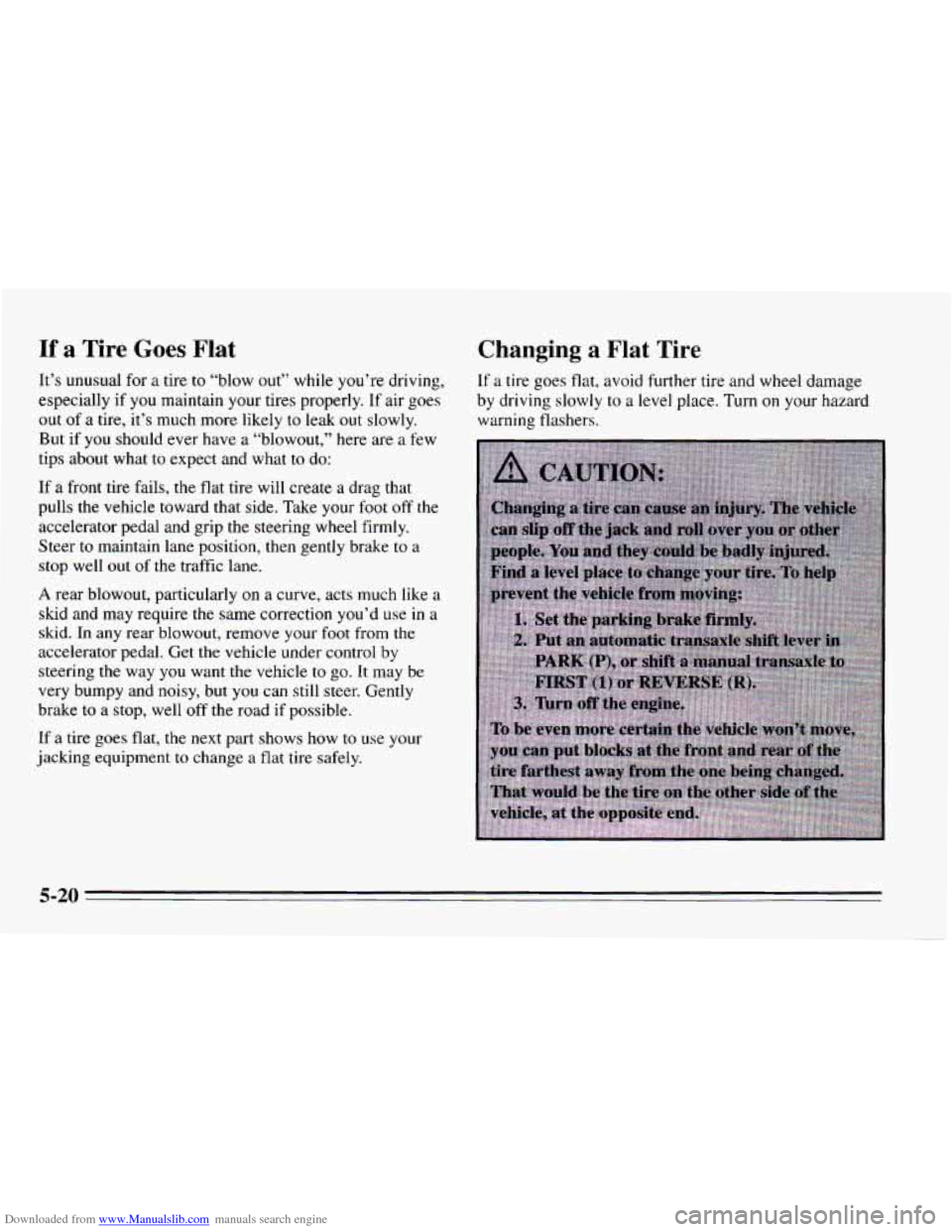
Downloaded from www.Manualslib.com manuals search engine If a Tire Goes Flat
It’s unusual for a tire to “blow out” while you’re driving,
especially if
you maintain your tires properly. If air goes
out of a tire, it’s much more likely
to leak out slowly.
But if you should ever have a “blowout,” here are a few
tips about what to expect and what to do:
If a front tire fails, the flat tire will create a drag that
pulls the vehicle toward that side. Take your foot off the
accelerator pedal and grip the steering wheel firmly.
Steer to maintain lane position, then gently brake to a
stop well out
of the traffic lane.
A rear blowout, particularly on a curve, acts much like a
skid and
may require the same correction you’d use in a
skid. In any rear blowout, remove your foot from the
accelerator pedal. Get the vehicle under control by
steering the way you want the vehicle to
go. It may be
very bumpy and noisy, but you can still steer. Gently
brake to
a stop, well off the road if possible.
If a tire goes flat, the next part shows how to use your
jacking equipment
to change a flat tire safely.
Changing a Flat Tire
If a tire goes flat, avoid further tire and wheel damage
by driving slowly
to a level place. Turn on your hazard
warning flashers.
5-20
Page 197 of 340
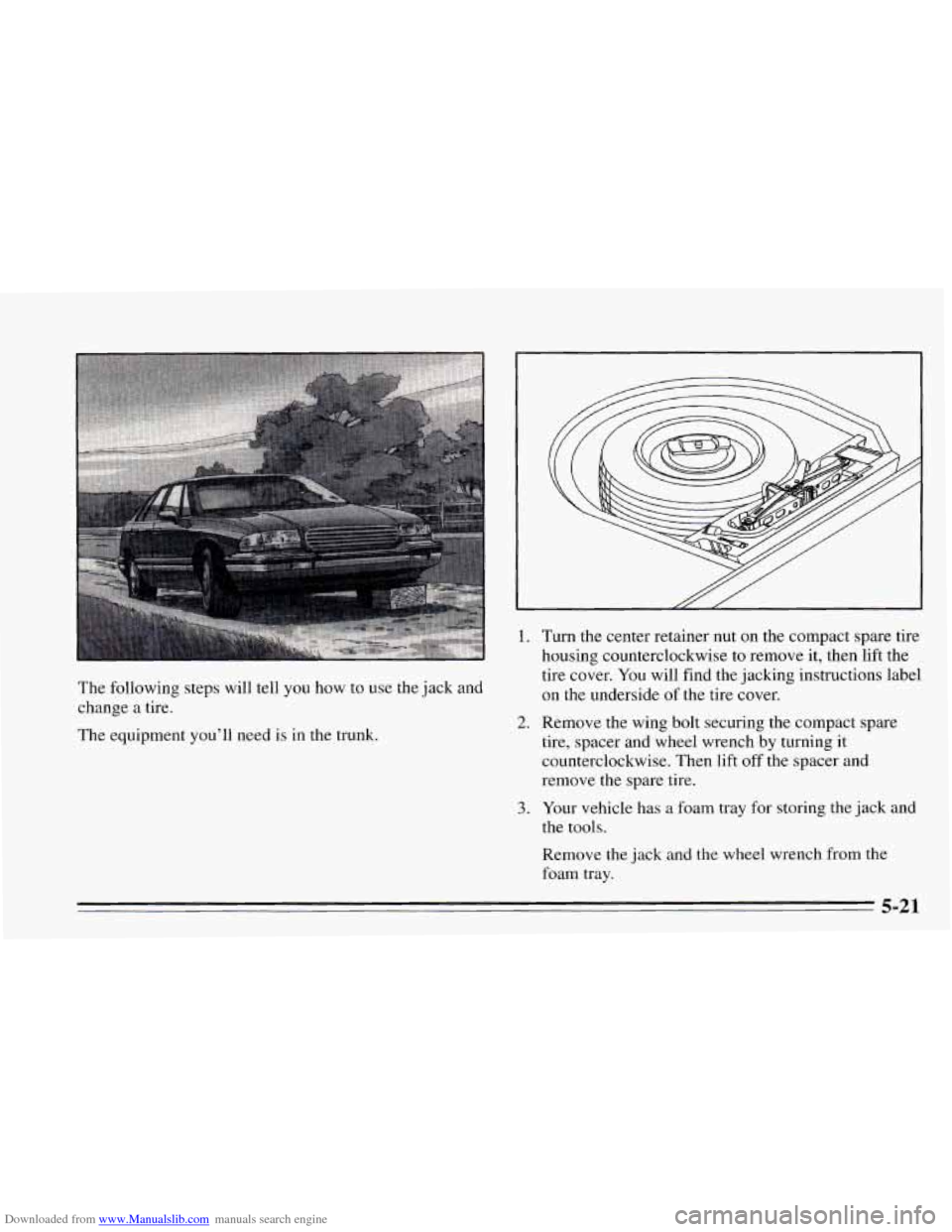
Downloaded from www.Manualslib.com manuals search engine The following steps will tell you how to use the jack and
change a tire.
The equipment you'll need is in the trunk.
1.
2.
3.
Turn the center retainer nut on the compact spare tire
housing counterclockwise to remove it, then lift the
tire cover. You will find the jacking instructions label
on the underside of the tire cover.
Remove the wing bolt securing the compact spare
tire, spacer and wheel wrench by turning it
counterclockwise. Then lift
off the spacer and
remove the spare tire.
Your vehicle has a foam tray for storing the jack and
the tools.
Remove the jack and the wheel wrench from the
foam tray.
5-21
Page 336 of 340
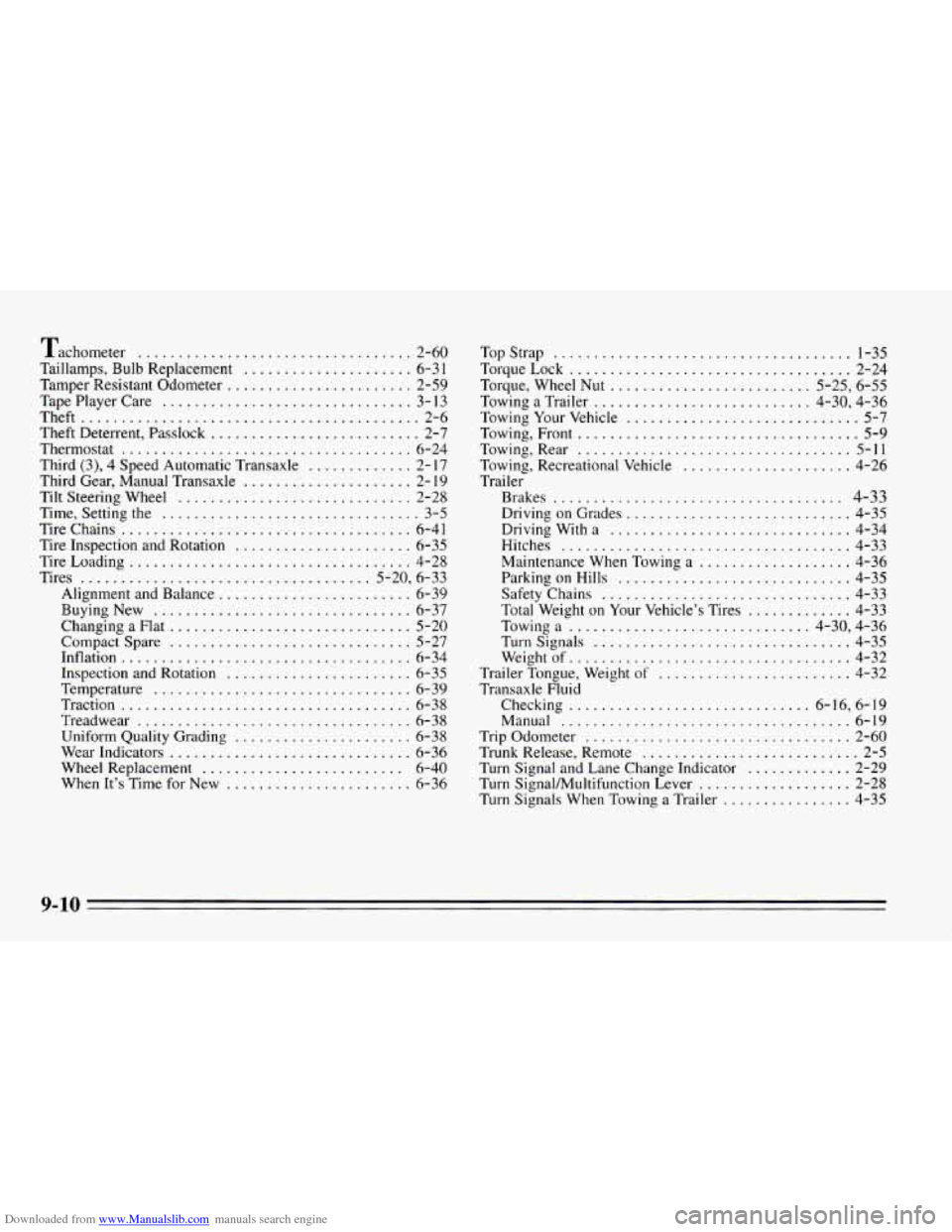
Downloaded from www.Manualslib.com manuals search engine Tachometer .................................. 2-60
Taillamps. Bulb Replacement
..................... 6-3 1
Tamper Resistant Odometer ....................... 2-59
TapePlayerCare
............................... 3-13
Theft
.......................................... 2-6
Theft Deterrent. Passlock
.......................... 2-7
Thermostat
.................................... 6-24
Third
(3). 4 Speed Automatic Transaxle ............. 2- 17
Third Gear. Manual Transaxle
..................... 2- 19
Tilt Steering Wheel
............................. 2-28
Time. Setting the
................................ 3-5
Tire Chains
.................................... 6-41
Tire Inspection and Rotation
...................... 6-35
TireLoading
................................... 4-28
Tires
.................................... 5-20. 6-33
Alignment and Balance
........................ 6-39
BuyingNew
................................ 6-37
ChangingaFlat
.............................. 5-20
Compact Spare .............................. 5-27
Inflation .................................... 6-34
Inspection and Rotation
....................... 6-35
Temperature
................................ 6-39
Traction
.................................... 6-38
Treadwear
.................................. 6-38
Uniform Quality Grading
...................... 6-38
Wear Indicators
.............................. 6-36
Wheel Replacement
......................... 6-40
When It’s Time for New
....................... 6-36 Top
Strap
..................................... 1-35
TorqueLock ................................... 2-24
Torque. Wheel
Nut ......................... 5.25. 6.55
Towing
a Trailer ........................... 4.30. 4.36
Towing Your Vehicle
............................. 5-7
Towing. Front ................................... 5-9
Towing. Rear .................................. 5-11
Towing. Recreational Vehicle
..................... 4-26
Trailer
Brakes
.................................... 4-33
Driving on Grades ............................ 4-35
DrivingWitha
.............................. 4-34
Hitches
.................................... 4-33
Maintenance When Towing
a ................... 4-36
Parking on Hills
............................. 4-35
Safety Chains
............................... 4-33
Total Weight on Your Vehicle’s Tires
............. 4-33
Towinga
.............................. 4-30. 4-36
Turn Signals
................................ 4-35
Weightof
................................... 4-32
Trailer Tongue. Weight
of ........................ 4-32
Transaxle Fluid
Checking
.............................. 6-16. 6.19
Manual
.................................... 6-19
Trip Odometer ................................. 2-60
Trunk Release. Remote
........................... 2-5
Turn Signal and Lane Change Indicator ............. 2-29
Turn SignalMultifunction Lever
................... 2-28
Turn Signals When Towing
a Trailer ................ 4-35
9-10